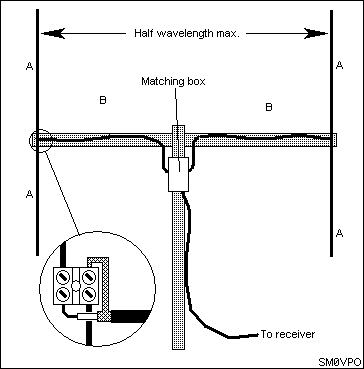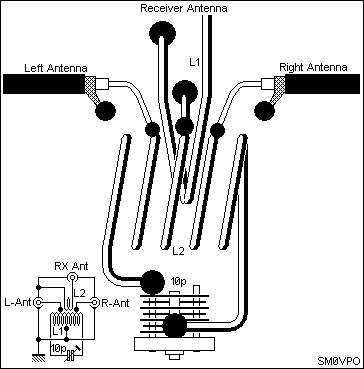

Here is a VERY narrow nulling VHF Direction Finding (DF) antenna that can be folded up int he back of the car, then you can leap out, assemble it and take a 'fix' in something like 10 seconds.
DF antennas come in all shapes and sizes, yet at most VHF foxhunts one mainly sees the old loop antenna and compas. The first foxhunt I was ever involved in was with the Cambridge & District Amateur Radio Society. I won it. The antenna I used was a pair of 1/2-wave verticals (A + A) spaced 1/2-wavelength apart. These were mounted on a wooden T shaped frame and the antenna elements fixed with simple household cable connector blocks, often refered to as 'chocolate block' connectors.

The two antennas are each fed into a tuned circuit via UR67 (B) cut to 0.66 x 1/2-wavelength. The centre-tap of the tuned circuit is grounded and each antenna is coupled to + and - one turn. This effectively cancels out the received signal only when the two incomming signals are in phase. The two signals are only in phase when the two antennas are equal distance from the target transmitter; the T mount is at right-angles to the direction to the transmitter. The tuned circuit is tuned for the part of the band you are interested in.

The tuning capacitor is something like 10pF and the coil is 5 turns 2.5cm (one inch) DIA. although this is not at all critical.
All the phasing bits can be mounted in a tobacco tin, throat lozenge tin, mustard tin etc. To set it up, tune into a strong signal and rotate the antenna for a DIP in the receiver S-meter (guess-meter?) and adjust the antenna tappings on the coil for a minimum. Minor adjustments can be obtained by moving the RX loop a little. It should be possible to get a dip of 60-80dB with this antenna, but when you get close to your target transmitter the dip will become so narrow that it is hard to see. It is almost impossible to hold the antenna still to keep it in the dip. As you get VERY close to the target transmitter it may be an advantage to use attenuators to reduce the signal strength.
Take one direction bearing then rotate the antenna through 180 degrees and take a second. The true heading is midway between the two. This will remove any directional error that may occur with the antenna. With two bearings you will see where they cross, do not go there for your third bearing, but go to one side of the target transmitters suspected position, you can then use this bearing and the last bearing to triangulate the target transmitter. You should aim to 'zoom in' on the target in an ever decreasing spiral.
It may not be a good idea to transmit into this antenna, but it will take it and the VSWR is not too bad. The 10pf tuning cap may arc or sparkalate if you use too much power.
